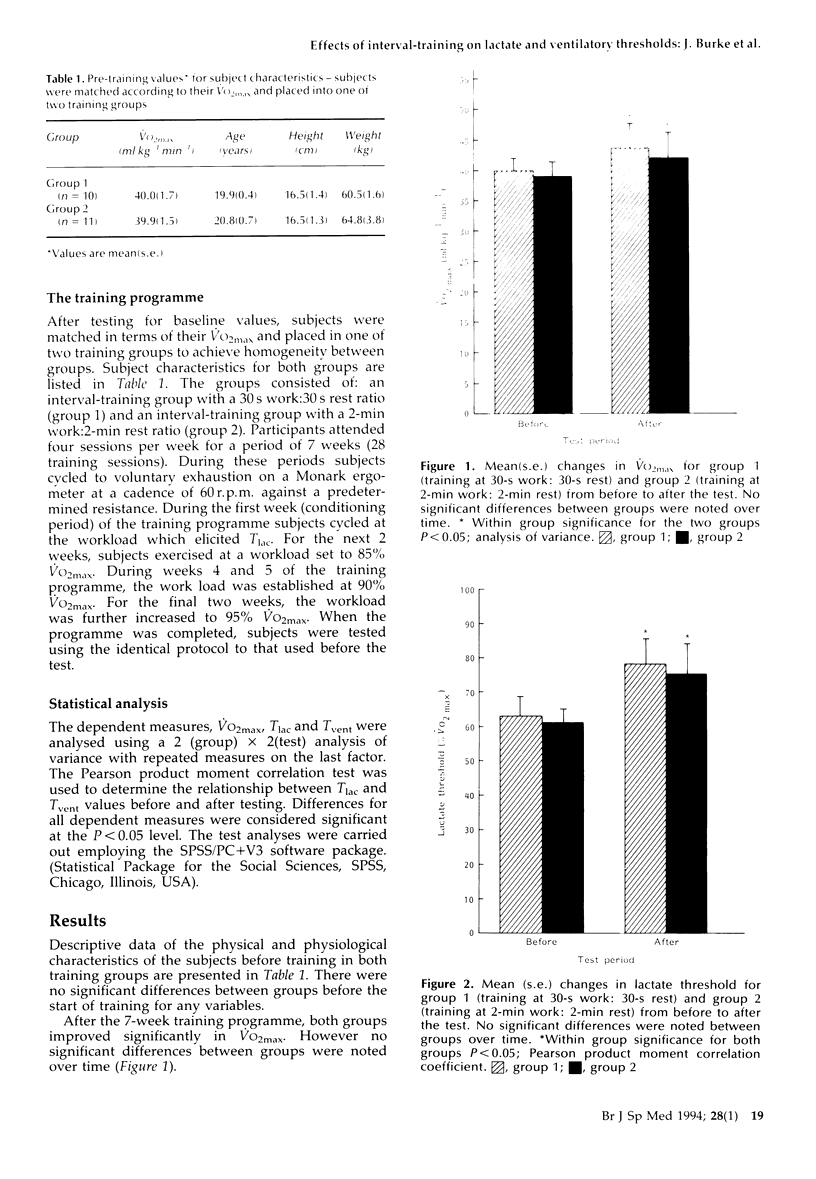Abstract
Twenty-one women subjects were matched in terms of their Vo2max and assigned to one of two groups: (1) training at 30 s; or (2) 2 min with a 1:1 work: relief ratio (1:1 WR) before participating in a 7-week training programme which began at an intensity of 85% Vo2max and increased 5% every two weeks (90% and 95% Vo2max). The subjects trained to exhaustion four times per week. Maximal oxygen consumption (Vo2max), lactate threshold (Tlac) and ventilatory threshold (Tvent) were determined before and after the training programme. After training, there were significant increases (P < 0.05) in Vo2max (5% and 6%), Tlac (19.4% and 22.4%), and Tvent (19.5% and 18.5%). There were no significant group differences on any dependent measure but this research adds support to previous training studies in that a strong correlation (P < 0.05) between Tlac and Tvent is maintained from before to after the test. It was concluded that both formats of high intensity aerobic interval-training produce similar changes in Vo2max, Tlac and Tvent and that these changes appear to be independent of the length of the work interval.
Full text
PDF



Selected References
These references are in PubMed. This may not be the complete list of references from this article.
- ASTRAND I., ASTRAND P. O., CHRISTENSEN E. H., HEDMAN R. Intermittent muscular work. Acta Physiol Scand. 1960 Apr 25;48:448–453. doi: 10.1111/j.1748-1716.1960.tb01879.x. [DOI] [PubMed] [Google Scholar]
- Acevedo E. O., Goldfarb A. H. Increased training intensity effects on plasma lactate, ventilatory threshold, and endurance. Med Sci Sports Exerc. 1989 Oct;21(5):563–568. [PubMed] [Google Scholar]
- Beaver W. L., Wasserman K., Whipp B. J. Improved detection of lactate threshold during exercise using a log-log transformation. J Appl Physiol (1985) 1985 Dec;59(6):1936–1940. doi: 10.1152/jappl.1985.59.6.1936. [DOI] [PubMed] [Google Scholar]
- Brooks G. A. Anaerobic threshold: review of the concept and directions for future research. Med Sci Sports Exerc. 1985 Feb;17(1):22–34. [PubMed] [Google Scholar]
- Casaburi R., Storer T. W., Wasserman K. Mediation of reduced ventilatory response to exercise after endurance training. J Appl Physiol (1985) 1987 Oct;63(4):1533–1538. doi: 10.1152/jappl.1987.63.4.1533. [DOI] [PubMed] [Google Scholar]
- Daniels J., Scardina N. Interval training and performance. Sports Med. 1984 Jul-Aug;1(4):327–334. doi: 10.2165/00007256-198401040-00006. [DOI] [PubMed] [Google Scholar]
- Dolgener F. A., Brooks W. B. The effects of interval and continuous training on VO2 max and performance in the mile run. J Sports Med Phys Fitness. 1978 Dec;18(4):345–352. [PubMed] [Google Scholar]
- Farrell S. W., Ivy J. L. Lactate acidosis and the increase in VE/VO2 during incremental exercise. J Appl Physiol (1985) 1987 Apr;62(4):1551–1555. doi: 10.1152/jappl.1987.62.4.1551. [DOI] [PubMed] [Google Scholar]
- Fox E. L., Robinson S., Wiegman D. L. Metabolic energy sources during continuous and interval running. J Appl Physiol. 1969 Aug;27(2):174–178. doi: 10.1152/jappl.1969.27.2.174. [DOI] [PubMed] [Google Scholar]
- Gollnick P. D., Saltin B. Significance of skeletal muscle oxidative enzyme enhancement with endurance training. Clin Physiol. 1982 Feb;2(1):1–12. doi: 10.1111/j.1475-097x.1982.tb00001.x. [DOI] [PubMed] [Google Scholar]
- Holloszy J. O., Coyle E. F. Adaptations of skeletal muscle to endurance exercise and their metabolic consequences. J Appl Physiol Respir Environ Exerc Physiol. 1984 Apr;56(4):831–838. doi: 10.1152/jappl.1984.56.4.831. [DOI] [PubMed] [Google Scholar]
- Hoppeler H., Howald H., Conley K., Lindstedt S. L., Claassen H., Vock P., Weibel E. R. Endurance training in humans: aerobic capacity and structure of skeletal muscle. J Appl Physiol (1985) 1985 Aug;59(2):320–327. doi: 10.1152/jappl.1985.59.2.320. [DOI] [PubMed] [Google Scholar]
- Hughes E. F., Turner S. C., Brooks G. A. Effects of glycogen depletion and pedaling speed on "anaerobic threshold". J Appl Physiol Respir Environ Exerc Physiol. 1982 Jun;52(6):1598–1607. doi: 10.1152/jappl.1982.52.6.1598. [DOI] [PubMed] [Google Scholar]
- Jansson E., Dudley G. A., Norman B., Tesch P. A. Relationship of recovery from intensive exercise to the oxidative potential of skeletal muscle. Acta Physiol Scand. 1990 May;139(1):147–152. doi: 10.1111/j.1748-1716.1990.tb08907.x. [DOI] [PubMed] [Google Scholar]
- MacDougall D., Sale D. Continuous vs. interval training: a review for the athlete and the coach. Can J Appl Sport Sci. 1981 Jun;6(2):93–97. [PubMed] [Google Scholar]
- McLellan T. M., Jacobs I. Active recovery, endurance training, and the calculation of the individual anaerobic threshold. Med Sci Sports Exerc. 1989 Oct;21(5):586–592. [PubMed] [Google Scholar]
- Morton R. H., Gass G. C. A systems model approach to the ventilatory anaerobic threshold. Eur J Appl Physiol Occup Physiol. 1987;56(3):367–373. doi: 10.1007/BF00690907. [DOI] [PubMed] [Google Scholar]
- Olsen R., Berg K., Latin R., Blanke D. Comparison of two intense interval training programs on maximum oxygen uptake and running performance. J Sports Med Phys Fitness. 1988 Jun;28(2):158–164. [PubMed] [Google Scholar]
- Poole D. C., Gaesser G. A. Response of ventilatory and lactate thresholds to continuous and interval training. J Appl Physiol (1985) 1985 Apr;58(4):1115–1121. doi: 10.1152/jappl.1985.58.4.1115. [DOI] [PubMed] [Google Scholar]
- Saltin B., Nazar K., Costill D. L., Stein E., Jansson E., Essén B., Gollnick D. The nature of the training response; peripheral and central adaptations of one-legged exercise. Acta Physiol Scand. 1976 Mar;96(3):289–305. doi: 10.1111/j.1748-1716.1976.tb10200.x. [DOI] [PubMed] [Google Scholar]
- Simon J., Young J. L., Blood D. K., Segal K. R., Case R. B., Gutin B. Plasma lactate and ventilation thresholds in trained and untrained cyclists. J Appl Physiol (1985) 1986 Mar;60(3):777–781. doi: 10.1152/jappl.1986.60.3.777. [DOI] [PubMed] [Google Scholar]
- Thomas T. R., Adeniran S. B., Etheridge G. L. Effects of different running programs on VO2 max, percent fat, and plasma lipids. Can J Appl Sport Sci. 1984 Jun;9(2):55–62. [PubMed] [Google Scholar]
- Walsh M. L., Banister E. W. Possible mechanisms of the anaerobic threshold. A review. Sports Med. 1988 May;5(5):269–302. doi: 10.2165/00007256-198805050-00001. [DOI] [PubMed] [Google Scholar]
- Wasserman K., Beaver W. L., Whipp B. J. Mechanisms and patterns of blood lactate increase during exercise in man. Med Sci Sports Exerc. 1986 Jun;18(3):344–352. doi: 10.1249/00005768-198606000-00017. [DOI] [PubMed] [Google Scholar]
- Yoshida T., Udo M., Chida M., Makiguchi K., Ichioka M., Muraoka I. Arterial blood gases, acid-base balance, and lactate and gas exchange variables during hypoxic exercise. Int J Sports Med. 1989 Aug;10(4):279–285. doi: 10.1055/s-2007-1024916. [DOI] [PubMed] [Google Scholar]


